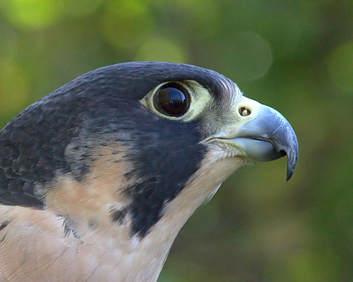Athena our Peregrine Falcon
Peregrine Falcon - Powerful and fast-flying, the Peregrine Falcon hunts medium-sized birds, dropping down on them from high above in a spectacular stoop. They were virtually eradicated from eastern North America by pesticide poisoning in the middle 20th century. After significant recovery efforts, Peregrine Falcons have made an incredible rebound and are now regularly seen in many large cities and coastal areas.
Athena came from Oregon. She was in another educational program called Sky Hunters. She arrived in their program in 2013 having recovered from a slash across the back of her right wing. She is capable of flight but because the wing droops, she is not able to reach optimum speed to hunt in flight thus making her non-releasable.
Habitat - The word "peregrine" means "wanderer" or "pilgrim," and Peregrine Falcons occur all over the world. In North America they breed in open landscapes with cliffs (or skyscrapers) for nest sites. They can be found nesting at elevations up to about 12,000 feet, as well as along rivers and coastlines or in cities, where the local Rock Pigeon populations offer a reliable food supply. In migration and winter you can find Peregrine Falcons in nearly any open habitat, but with a greater likelihood along barrier islands, mudflats, coastlines, lake edges, and mountain chains.
Diet - Peregrine Falcons eat mostly birds, of an enormous variety—450 North American species have been documented as prey, and the number worldwide may be as many as 2,000 species. They have been observed killing birds as large as a Sandhill Crane, as small as a hummingbird, and as elusive as a White-throated Swift. Typical prey include shorebirds, ptarmigan, ducks, grebes, gulls, storm-petrels, pigeons, and songbirds including jays, thrushes, longspurs, buntings, larks, waxwings, and starlings. Peregrine Falcons also eat substantial numbers of bats. They occasionally pirate prey, including fish and rodents, from other raptors.
Nesting - Typically, Peregrine Falcons nest on cliffs from about 25–1,300 feet high (and higher, including on the rim of the Grand Canyon). On these cliffs they choose a ledge that is typically around a third of the way down the cliff face. Other sites include electricity transmission towers, quarries, silos, skyscrapers, churches, and bridges. In places without cliffs, Peregrines may use abandoned Common Raven, Bald Eagle, Osprey, Red-tailed Hawk, or cormorant nests. In the Pacific Northwest they may nest among or under Sitka spruce tree roots on steep slopes.
Athena came from Oregon. She was in another educational program called Sky Hunters. She arrived in their program in 2013 having recovered from a slash across the back of her right wing. She is capable of flight but because the wing droops, she is not able to reach optimum speed to hunt in flight thus making her non-releasable.
Habitat - The word "peregrine" means "wanderer" or "pilgrim," and Peregrine Falcons occur all over the world. In North America they breed in open landscapes with cliffs (or skyscrapers) for nest sites. They can be found nesting at elevations up to about 12,000 feet, as well as along rivers and coastlines or in cities, where the local Rock Pigeon populations offer a reliable food supply. In migration and winter you can find Peregrine Falcons in nearly any open habitat, but with a greater likelihood along barrier islands, mudflats, coastlines, lake edges, and mountain chains.
Diet - Peregrine Falcons eat mostly birds, of an enormous variety—450 North American species have been documented as prey, and the number worldwide may be as many as 2,000 species. They have been observed killing birds as large as a Sandhill Crane, as small as a hummingbird, and as elusive as a White-throated Swift. Typical prey include shorebirds, ptarmigan, ducks, grebes, gulls, storm-petrels, pigeons, and songbirds including jays, thrushes, longspurs, buntings, larks, waxwings, and starlings. Peregrine Falcons also eat substantial numbers of bats. They occasionally pirate prey, including fish and rodents, from other raptors.
Nesting - Typically, Peregrine Falcons nest on cliffs from about 25–1,300 feet high (and higher, including on the rim of the Grand Canyon). On these cliffs they choose a ledge that is typically around a third of the way down the cliff face. Other sites include electricity transmission towers, quarries, silos, skyscrapers, churches, and bridges. In places without cliffs, Peregrines may use abandoned Common Raven, Bald Eagle, Osprey, Red-tailed Hawk, or cormorant nests. In the Pacific Northwest they may nest among or under Sitka spruce tree roots on steep slopes.
